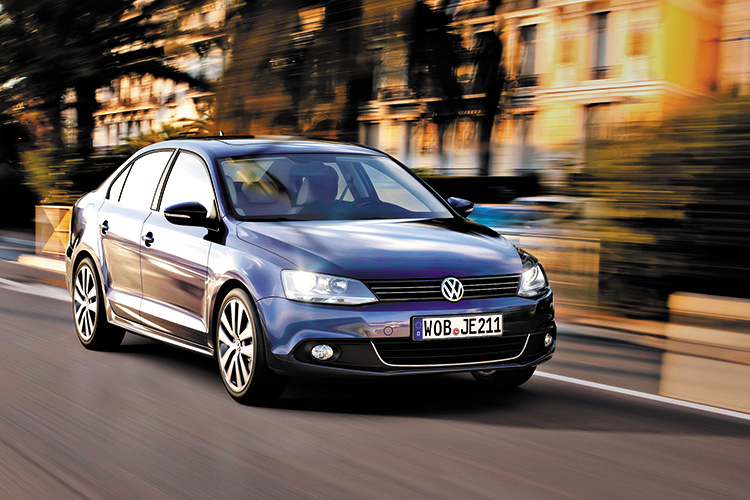
Volkswagen has taken a two-pronged approach with its new Jetta saloon – it’s a cut-price model for the US market and a classier edition for Europe. (The latter is destined for these shores in the middle of this year.)
The Jetta that made its international debut in San Francisco last August (and reviewed in our September 2010 edition) is for Americans, while the more expensively specified version tested here is for the rest of the world. Both cars are made at the same plant in Puebla, Mexico.

Volkswagen Jetta’s Golf-based cabin is well-made, user-friendly and more spacious than that hatchback’s.
Visually, only a keen-eyed VW freak would be able to differentiate the US and European models of the latest Jetta. Their dissimilarity is mainly in the bumpers, exterior lamps and radiator grille. More importantly, with this Mark 6 model, Volkswagen’s design team led by maestro Walter de’Silva has made the effort to further separate the Jetta’s styling from its Golf hatchback cousin’s. So, unlike the previous Jetta, this new one doesn’t share a single body panel with the Golf, instead sporting its own distinct look and feel. At 4644mm in length, the newcomer is a noticeable 90mm longer than its predecessor, and sits between the Golf and the Passat in dimensions.
It is underneath the sheet metal where the Euro Jetta differs greatly from the American variant. While the smallest engine available in the US model is an ancient, naturally aspirated 2-litre 4-cylinder with 115bhp, the Euro model’s petrol engine line-up consists mostly of turbocharged TSI lumps that range from 1.2 litres to 2 litres in capacity.

Volkswagen Jetta’s gigantic 510-litre boot can swallow plenty of travel luggage or a couple of fully loaded golf bags.
We drove the entry-level petrol 1.2 TSI model with 6-speed manual gearbox at the Jetta international driving presentation in Nice. The drivetrain, shared with the Polo Sport, proved surprisingly adequate on the winding roads in and around the Cote d’Azur. With the vehicle weighing 1.3 tonnes, the little engine needs close to 11 seconds for its 0-100km/h sprint, but this is good enough to see off most Japanese 1.6-litre saloons.
The lack of a DSG option for this engine, however, means it will not be coming to Singapore. What we will get instead is a 1.4-litre TSI unit in either 122bhp turbo or 160bhp Twincharged form, mated to a 7-speed dry-clutch DSG. A 2-litre 200bhp flagship badged “GLI” is also on the cards. A hybrid option will be introduced later, perhaps in early 2012.

Unlike the cost-conscious US Jetta, which comes with a simple torsion beam rear suspension, the Euro Jetta is equipped with the Golf’s sophisticated multi-link setup, which helps the car ride and handle more convincingly.
The Jetta’s dynamics certainly feel assuring and composed, both on an autoroute cruise and along the tight, twisty country roads outside the city of Nice. Furthermore, its more generous wheelbase vis-a-vis the Golf gives it an added edge over the hatchback when it comes to high-speed stability and general ride comfort.

New Volkswagen Jetta rides more comfortably than the Volkswagen Golf.
Interior materials are higher in quality compared to those in the American Jetta. As with the exterior, the cabin is derived from the Golf’s, but redesigned slightly. It employs the same familiar switchgear and instruments. Ambience is pleasant, while the extended wheelbase means extra legroom for rear passengers who just stepped out of a Golf. The boot, needless to say, is huge and thoughtfully shaped, while the loading lip is located at bumper level for convenience.
The outgoing Jetta was a key contributor to Volkswagen’s stellar sales performance in Singapore last year. With its many improvements, the new Jetta is likely to ride on the popularity of its predecessor and achieve similar success.

Volkswagen Jetta 1.2
ENGINE 1197cc, 16-valves, inline-4, turbocharged
MAX POWER 105bhp at 5000rpm
MAX TORQUE 175Nm at 1550-4100rpm
GEARBOX 6-speed manual
0-100KM/H 10.9 seconds
TOP SPEED 190km/h
CONSUMPTION 17.5km/L (combined)
PRICE INCL. COE Not applicable (as of March 2011)
The Renault Megane Sedan and Skoda Octavia are the Volkswagen Jetta’s main rivals
Group Test: Renault Megane Sedan Privilege 1.5 vs Volkswagen Jetta Sportline 1.4
Group Test: Volkswagen Jetta 1.4 versus Toyota Corolla Altis 1.6












